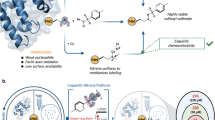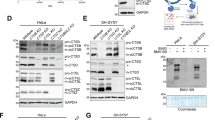Abstract
Purpose. We examined the metal-catalyzed oxidation of brain-derivedneurotrophic factor (BDNF) using the Cu(II)/ascorbate/O2 modeloxidative system.
Methods. Electrospray ionization mass spectrometry, peptide mappingand amino acid analysis were utilized to determine the nature of thecovalent modification induced by the metal-catalyzed oxidative system.Additionally, analytical ultracentrifugation, the Bradford assay, circulardichroism and ANSA dye-binding were used to determine the natureof any conformational changes induced by the oxidation.
Results. Exposure of BDNF to the Cu(II)/ascorbate/O2 system led tothe modification of ca. 35% of Met92 to its sulfoxide, and to subsequentconformational changes. The proteolytic digestion procedure wassensitive to this conformational change, and was unable to detect themodification. Chemical digestion with CNBr, however, was not sensitive tothis change, and allowed for the identification of the site ofmodification.
Conclusions. The modification of Met92 to its sulfoxide rendered theoxidized BDNF inaccessible to proteolytic digestion, due toconformational changes associated with the oxidation.
Similar content being viewed by others
REFERENCES
J. L. Cleland, M. F. Powell, and S. J. Shire. The development of stable protein formulations: a close look at protein aggregation, deamidation, and oxidation. Crit. Rev. Ther. Drug Carrier Syst. 10:307-377 (1993).
S. Li, T. H. Nguyen, Ch. Schöneich, and R. T. Borchardt. Aggregation and precipitation of human relaxin induced by metal-catalyzed oxidation. Biochemistry 34:5762-5772 (1995).
F. Zhao, E. Ghezzo-Schöneich, G. I. Aced, J. Hong, T. Milby, and Ch. Schöneich. Metal-catalyzed oxidation of histidine in human growth hormone. J. Biol. Chem. 272:9019-9029 (1997).
Ch. Schöneich, M. J. Hageman, and R. T. Borchardt. Stability of peptides and proteins. In K. Park (ed), Controlled Drug Delivery: Challenges and Strategies, American Chemical Society, 1997, pp. 205-228.
R. R. Beitle and M. M. Atai. Immobilized metal affinity chromatography and related techniques. AlChE Symposium Series 88:34-44 (1992).
E. Hochuli. Large-scale chromatography of recombinant proteins. J. Chromatogr. 444:293-302 (1988).
U. Zawitowska, J. Zawitowski, and A. D. Friesen. Applications of immobilized metal affinity chromatography for large-scale purification of endogenous α-amylase inhibitor from barley kernels. Biotechnol. Appl. Biochem. 15:160-170 (1992).
E. R. Stadtman. Metalion catalyzed oxidation of proteins: biochemical mechanism and biological consequences. Free Radic. Biol. Med. 9:315-325 (1990).
A. J. Rivett and R. L. Levine. Metal-catalyzed oxidation of escherichia coli glutamine synthetase: correlation of structural and functional changes. Arch. Biochem. Biophys. 278:26-34 (1990).
N. Lundell and T. Schreitmüller. Sample preparation for peptide mapping-a pharmaceutical quality-control perspective. Anal. Biochem. 266:31-47 (1999).
C. Radziejewski, R. C. Robinson, P. S. DiStefano, and J. W. Taylor. Dimeric structure and conformational stability of brain-derived neurotrophic factor and neurotrophin-3. Biochemistry 31:4431-4436 (1992).
J. Ozols. Amino acid analysis. Methods Enzymol. 182:587-601 (1990).
W. J. Ray and D. E. J. Koshland. Identification of amino acids involved in phosphoglucomutase action. J. Biol. Chem. 237:2493-2505 (1962).
H. T. Keutmann and J. T. J. Potts. Improved recovery of methionine after acid hydrolysis using mercaptoethanol. Anal. Biochem. 29:175-185 (1969).
N. F. Floyd, M. S. Cammaroti, and T. F. Lavine. The decomposition of dl-methionine sulfoxide in 6 N hydrochloric acid. Arch. Biochem. Biophys. 102:343 (1963).
R. J. Simpson, M. R. Neuberger, and T. Y. Liu. Complete amino acid analysis of proteins from a single hydrolysate. J. Biol. Chem. 251:1936-1940 (1976).
M. M. Bradford. A rapid and sensitive method for the quantitation of microgram quantities of protein utilizing the principle of protein-dye binding. Anal. Biochem. 72:248-254 (1976).
K. Morand, G. Talbo, and M. Mann. Oxidation of peptides during electrospray ionization. Rapid Commun. Mass Spectrom. 7:738-743 (1993).
N. Neumann and G. Snatzke. Circular dichroism of proteins. In R. A. Bradshaw and M. Purton (eds), Proteins: Form and Function, Elsevier, New York, 1990, pp. 107-116.
L. O. Narhi, R. Rosenfeld, J. Talvenheimo, S. J. Pestrelski, T. Arakawa, J. W. Lary, C. G. Kolvenbach, R. Hecht, T. Boone, J. A. Miller, and D. A. Yphantis. Comparison of the biophysical characteristics of human brain-derived neurotrophic factor, neurotrophin-3, and nerve growth factor. J. Biol. Chem. 268:13309-13317 (1993).
J. S. Philo, R. Rosenfeld, T. Arakawa, J. Wen, and L. O. Narhi. Refolding of brain-derived neurotrophic factor from guanidine hydrochloride: kinetic trapping in a collapsed form which is incompetent for dimerization. Biochemistry 32:10812-10818 (1993).
J. Slavik. Anilinonaphtalene sulfonate as a probe of membrane composition and function. Biochim. Biophys. Acta 694:1-25 (1982).
G. V. Semisotnov, N. A. Rodionova, O. I. Razgulyaev, V. N. Uversky, A. F. Gripas, and R. I. Gilmanshin. Study of the “molten globule” intermediate state in protein folding by a hydrophobic fluorescent probe. Biopolymers 31:119-128 (1991).
W. R. Kirk, E. Kurian, and F. G. Prendergast. Characterization of the sources of protein-ligand affinity: 1-sulfonato-8-(18') anilinonaphtalene binding to intestinal fatty acid binding protein. Biophys. J. 70:69-83 (1996).
D. Matulis and R. Lovrien. 1-Anilino-8-naphtalene sulfonate anion-protein binding depends primarily on ion pair formation. Biophys. J. 74:422-429 (1998).
D. Matulis, C. G. Baumann, V. A. Bloomfield, and R. E. Lovrien. 1-Anilino-8-naphtalene sulfonate as a protein conformational tightening agent. Biopolymers 49:451-458 (1999).
S. K. Banerjee and J. B. Mudd. Reaction of ozone with glycophorin in solution and in lipid vesicles. Arch. Biochem. Biophys. 295:84-89 (1992).
D. R. Goodlett, F. B. Armstrong, R. J. Creech, and R. B. van Breemen. Formylated peptides from cyanogen bromide digests identified by fast atom bombardement mass spectrometry. Anal. Biochem. 186:116-120 (1990).
G. P. Dado and S. H. Gellman. Redox control of secondary structure in a designed peptide. J. Am. Chem. Soc. 115:12609-12610 (1993).
R. C. Robinson, C. Radziejewski, D. I. Stuart, and E. Y. Jones. Structure of the brain-derived neurotrophic factor/neurotrophin 3 heterodimer. Biochemistry 34:4139-4146 (1995).
Author information
Authors and Affiliations
Rights and permissions
About this article
Cite this article
Jensen, J.L., Kolvenbach, C., Roy, S. et al. Metal-Catalyzed Oxidation of Brain-Derived Neurotrophic Factor (BDNF): Analytical Challenges for the Identification of Modified Sites. Pharm Res 17, 190–196 (2000). https://doi.org/10.1023/A:1007569431038
Issue Date:
DOI: https://doi.org/10.1023/A:1007569431038




